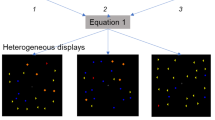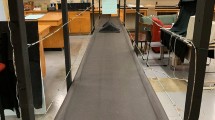Abstract
EACH of the shapes illustrated in Fig. 1 has the same surface area but when comparing them most people agree that they appear to differ appreciably in size. From a study in which visual stimuli were presented within angular contours, Fisher concluded that “… the apparent features of illusory patterns rather than their actual physical characteristics determine the probability with which near-threshold stimuli can be detected”1. If this statement refers generally to two-dimensional forms, then circular, square and triangular shapes should be identified in accordance with their apparent rather than their real sizes.
This is a preview of subscription content, access via your institution
Access options
Subscribe to this journal
Receive 51 print issues and online access
$199.00 per year
only $3.90 per issue
Buy this article
- Purchase on Springer Link
- Instant access to full article PDF
Prices may be subject to local taxes which are calculated during checkout
Similar content being viewed by others
References
Fisher, G. H., Nature, 215, 553 (1967).
Anastasi, A., J. Gen. Psychol., 14, 201 (1936).
Warren, J. M., and Pinneau, S. R., Percept. Motor Skills, 5, 7 (1955).
Graham, C. H., Vision and Visual Perception (Wiley, New York, 1965).
Author information
Authors and Affiliations
Rights and permissions
About this article
Cite this article
FISHER, G., FOSTER, J. Apparent Sizes of Different Shapes and the Facility with which they can be identified. Nature 219, 653–654 (1968). https://doi.org/10.1038/219653c0
Received:
Revised:
Issue Date:
DOI: https://doi.org/10.1038/219653c0
Comments
By submitting a comment you agree to abide by our Terms and Community Guidelines. If you find something abusive or that does not comply with our terms or guidelines please flag it as inappropriate.



